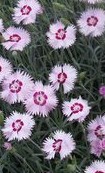 This herbaceous perennial is a member of the carnation family (Caryophyllaceae) that also includes baby’s breath, campions (Lynchis), and soapworts. It is native to Eurasia, has been cultivated for many years, and bred with carnations (Dianthus caryophyllum) to produce a very large number of dwarf hybrids such as cottage pinks, border pinks, and old laced pinks. The plant forms a loose hummock of grass-like, gray-green leaves, one to four inches long, and conspicuously veined. The clove-scented, one inch wide flowers are produced two per stem in early summer, and may be pink-lilac, pink-purple, or white. They have five fringed petals that are deeply cut and a throat bearded with long hairs. Pinks do not do well in hot climates or in soil that is wet in the winter. The generic name, Dianthus, comes from the Greek words dios, meaning divine, and anthos meaning flower. The specific epithet, plumarius means feathered and refers to the fringed, deeply cut petals.
This herbaceous perennial is a member of the carnation family (Caryophyllaceae) that also includes baby’s breath, campions (Lynchis), and soapworts. It is native to Eurasia, has been cultivated for many years, and bred with carnations (Dianthus caryophyllum) to produce a very large number of dwarf hybrids such as cottage pinks, border pinks, and old laced pinks. The plant forms a loose hummock of grass-like, gray-green leaves, one to four inches long, and conspicuously veined. The clove-scented, one inch wide flowers are produced two per stem in early summer, and may be pink-lilac, pink-purple, or white. They have five fringed petals that are deeply cut and a throat bearded with long hairs. Pinks do not do well in hot climates or in soil that is wet in the winter. The generic name, Dianthus, comes from the Greek words dios, meaning divine, and anthos meaning flower. The specific epithet, plumarius means feathered and refers to the fringed, deeply cut petals.
Type: Herbaceous perennial
Bloom: Fragrant, one inch wide flowers, two per stem, pink-lilac, pink-purple, or white in early summer
Size: 6” H x 12” W
Light: Full sun
Soil: Average, moist, well-drained, limy
Hardiness: Zones 4-7
Care: Deadhead to prolong bloom
Pests and Diseases: Slugs
Propagation: Seed but cuttings of selected forms in spring or summer are superior.
Companion plants: Lavender, cornflower, other Dianthus